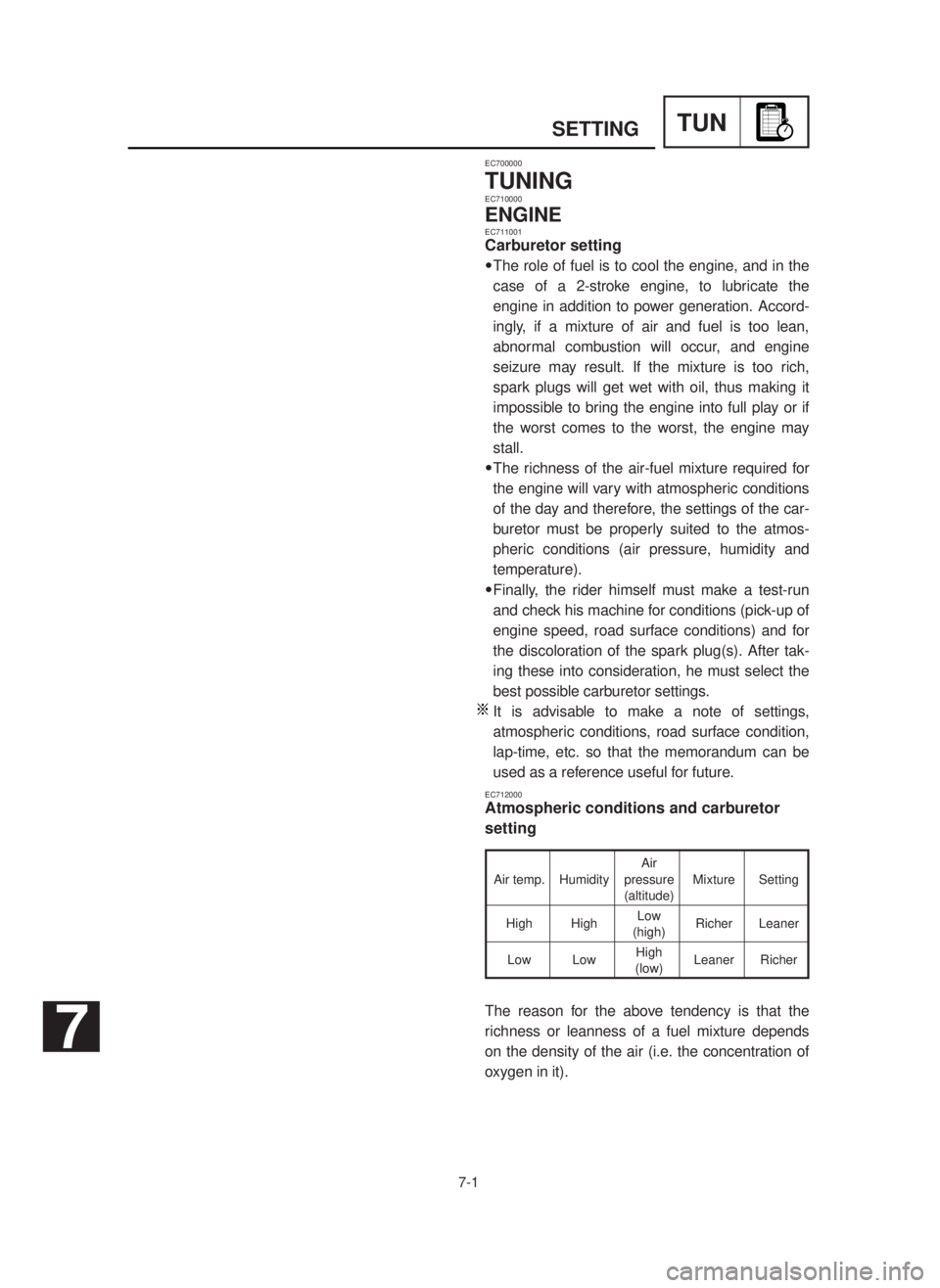Page 516 of 578
6-11
TPS (THROTTLE POSITION SENSOR) SYSTEMELEC
7. Adjust:
9Idle speed for TPS adjustment
8. Disconnect the TPS coupler.
9. Calculate:
9TPS coil resistance at idle speed.
If the TPS coil resistance is 5k½, then the TPS
coil resistance at idle speed is:
5k½´(0.13~0.15) = 650~750½
Refer to “TPS COIL INSPECTION” section
about the TPS coil resistance.
10. Adjust:
9TPS coil resistance at idle speed
Idle speed for TPS adjustment:
1,700~1,900 rpm
Adjustment steps:
9Set the inductive tachometer (engine
tachometer) to the high tension cord.
9Turn the throttle stop screw 1until the
specified idle speed.
Refer to “IDLE SPEED ADJUSTMENT” sec-
tion in the CHAPTER 3.
TPS coil resistance at idle speed:
TPS coil resistance ´(0.13~0.15)
Tester (+) leadÕYellowlead 2
Tester (–) lead
ÕBlacklead 3 Adjustment steps:
Adjust the angle of the TPS 1to obtain the
resistance calculated (example: 650~750½).
5MW-9-30-6 7/6/00 1:39 PM Page 28
Page 520 of 578

7-1
SETTINGTUN
EC700000
TUNINGEC710000
ENGINEEC711001
Carburetor setting
9The role of fuel is to cool the engine, and in the
case of a 2-stroke engine, to lubricate the
engine in addition to power generation. Accord-
ingly, if a mixture of air and fuel is too lean,
abnormal combustion will occur, and engine
seizure may result. If the mixture is too rich,
spark plugs will get wet with oil, thus making it
impossible to bring the engine into full play or if
the worst comes to the worst, the engine may
stall.
9The richness of the air-fuel mixture required for
the engine will vary with atmospheric conditions
of the day and therefore, the settings of the car-
buretor must be properly suited to the atmos-
pheric conditions (air pressure, humidity and
temperature).
9Finally, the rider himself must make a test-run
and check his machine for conditions (pick-up of
engine speed, road surface conditions) and for
the discoloration of the spark plug(s). After tak-
ing these into consideration, he must select the
best possible carburetor settings.
It is advisable to make a note of settings,
atmospheric conditions, road surface condition,
lap-time, etc. so that the memorandum can be
used as a reference useful for future.
EC712000
Atmospheric conditions and carburetor
setting
The reason for the above tendency is that the
richness or leanness of a fuel mixture depends
on the density of the air (i.e. the concentration of
oxygen in it).
Air
Air temp. Humidity pressure Mixture Setting
(altitude)
High HighLow
Richer Leaner
(high)
Low LowHigh
Leaner Richer
(low)
7
5MW-9-30-7 7/6/00 2:15 PM Page 2
Page 522 of 578
7-2
SETTINGTUN
That is:
9Higher temperature expands the air with its
resultant reduced density.
9Higher humidity reduces the amount of oxygen
in the air by so much of the water vapor in the
same air.
9Lower atmospheric pressure (at a high altitude)
reduces the density of the air.
EC713001
Test run
After warming up the engine equipped with the
standard type carburetor(s) and spark plug(s),
run two or three laps of the circuit and check the
smooth operation of the engine and discoloration
of spark plug(s).
ŒNormal
ºOver burned (too lean)
Oil fouled (too rich)
Discoloration Condition of spark plug
NormalInsulator is dry and
burnt brown.
Over burned
Insulator is whitish.
(too lean)
Oil fouled Insulator is sooty and
(too rich) wet.
A
B
C
5MW-9-30-7 7/6/00 2:16 PM Page 4
Page 546 of 578

7-12
SETTINGTUN
EC71M001
Change of the heat range of spark plugs
Judging from the discoloration of spark plugs, if
they are found improper, it can be corrected by
the following two methods; changing carburetor
settings and changing the heat range of spark
plug.
9In principle, it is advisable to first use spark
plugs of standard heat range, and judging from
the discoloration of spark plugs, adjust carbure-
tor settings.
9If the calibration No. of the main jet must be
changed by ±30, it is advisable to change the
heat range of spark plugs and newly select the
proper main jet.
NOTE:
9When checking the discoloration of spark
plugs, be sure to stop the engine immediately
after a run and check.
9Avoid racing.
9When changing the heat range of spark plugs,
never attempt to change it more than ±1 rank.
9When using spark plugs other than standard,
make sure of the difference in heat range and
find the equivalent to the standard.
9Note that even if the discoloration seems prop-
er, it may slightly vary with the spark plug
maker and oil in use.
Standard spark plug BR8EG/NGK
5MW-9-30-7 7/6/00 2:19 PM Page 28
Page 552 of 578

7-15
SETTINGTUN
A
EC722011
Front fork setting
The front fork setting should be made depending
on the rider’s feeling of an actual run and the cir-
cuit conditions.
The front fork setting includes the following three
factors:
1. Setting of air spring characteristics
9Change the fork oil level.
2. Setting of spring preload
9Change the spring.
9Install the adjustment washer.
3. Setting of damping force
9Change the compression damping.
9Change the rebound damping.
The spring acts on the load and the damp-
ing force acts on the cushion travel speed.
EC723001
Change in level and characteristics of fork oil
Damping characteristic near the final stroke can
be changed by changing the fork oil amount.
cC
Adjust the oil level in 5 mm (0.2 in) incre-
ments or decrements. Too low oil level
causes the front fork to produce a noise at
full rebound or the rider to feel some pres-
sure on his hands or body. Alternatively,
too high oil level will develop unexpectedly
early oil lock with the consequent shorter
front fork travel and deteriorated perfor-
mance an characteristics. Therefore, adjust
the front fork within the specified range.
ŒAir spring characteristics in relation to oil level
change
ºLoad
Stroke
1Max. oil level
2Standard oil level
3Min. oil level
Standard oil level:
135 mm (5.31 in)
Extent of adjustment:
80~150 mm (3.15~5.91 in)
From top of outer tube with
inner tube and damper rod fully
compressed without spring.
5MW-9-30-7 7/6/00 2:30 PM Page 34
Page 568 of 578

7-23
SETTINGTUN
EC72H010
Suspension setting
9Front fork
NOTE:
9If any of the following symptoms is experienced with the standard position as the base, make reset-
ting by reference to the adjustment procedure given in the same chart.
9Before any change, set the rear shock absorber sunken length to the standard figure 90~100 mm
(3.5~3.9 in).
Section
Symptom
JumpLarge
Medium Small Check Adjust
gap gap gap
Compression damping Turn adjuster counterclockwise (about 2 clicks)
Stiff over entire to decrease damping.
range111Oil level (oil amount) Decrease oil level by about 5~10 mm (0.2~0.4
in).
Spring Replace with soft spring.
Unsmooth Outer tube Check for any bends, dents, and other notice-
movement over 1111Inner tube able scars, etc. If any, replace affected parts.
entire range
Under bracket tightening Retighten to specified torque.
torque
Poor initial Rebound damping Turn adjuster counterclockwise (about 2 clicks)
movement1to decrease damping.
Oil seal Apply grease in oil seal wall.
Compression damping Turn adjuster clockwise (about 2 clicks) to in-
Soft over entire crease damping.
range, bottoming 11Oil level (oil amount) Increase oil level by about 5~10 mm (0.2~0.4
outin).
Spring Replace with stiff spring.
Stiff toward stroke
1Oil level (oil amount) Decrease oil level by about 5 mm (0.2 in).
end
Soft toward stroke
1Oil level (oil amount) Increase oil level by about 5 mm (0.2 in).
end, bottoming out
Stiff initial
1111Compression dampingTurn adjuster counterclockwise (about 2 clicks)
movement to decrease damping.
Compression damping Turn adjuster clockwise (about 2 clicks) to in-
crease damping.
Low front, tending Rebound damping Turn adjuster counterclockwise (about 2 clicks)
to lower front 11to decrease damping.
postureBalance with rear end Set sunken length for 95~100 mm (3.7~3.9 in)
when one passenger is astride seat (lower rear
posture).
Oil level (oil amount) Increase oil level by about 5 mm (0.2 in).
Compression damping Turn adjuster counterclockwise (about 2 clicks)
to decrease damping.
“Obtrusive” front, Balance with rear end Set sunken length for 90~95 mm (3.5~3.7 in)
tending to upper 11when one passenger is astride seat (upper rear
front postureposture).
Spring Replace with soft spring.
Oil lever (oil amount) Decrease oil level by about 5~10 mm (0.2~0.4
in).
5MW-9-30-7 7/6/00 2:32 PM Page 50